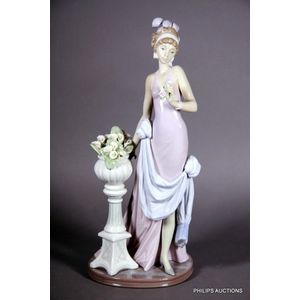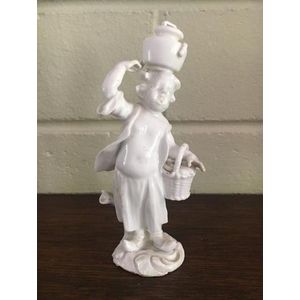Meissen Porcelain Cupid Street Vendor, 1750
You must be a subscriber, and be logged in to view price and dealer details.
Subscribe Now to view actual auction price for this item
When you subscribe, you have the option of setting the currency in which to display prices to $Au, $US, $NZ or Stg.
- Circa - A Latin term meaning 'about', often used in the antique trade to give an approximate date for the piece, usually considered to be five years on either side of the circa year. Thus, circa 1900 means the piece was made about 1900, probably between 1895 and 1905. The expression is sometimes abbreviated to c.1900.
- Cupid Motif - The Cupid motif, which features the Roman god of love and desire, Cupid, was a popular decorative element in classical ornamentation. Cupid was often depicted as a winged, naked baby with a bow and arrow, and was often used to symbolize love and desire.
In classical art and architecture, Cupid motifs were often used as decorative elements on furniture, such as on the legs of chairs and tables, as well as on architectural elements such as friezes and pediments. They were also used as decorative elements in frescoes, mosaics, and other forms of art.
During the Renaissance, Cupid motifs were often incorporated into the decoration of palaces, churches and other grand buildings, as they were seen as symbols of love and fertility. Cupid motifs were also commonly used in the decorative arts of the Baroque period, often appearing in the form of putti, which are small winged cherub figures.
In addition to their decorative use, Cupid motifs were also believed to hold symbolic meaning, as they were thought to evoke feelings of love, desire, and fertility.
This item has been included into following indexes:
Visually similar items

Lladro: Spanish porcelain statues of a girl with staff and a young woman with hat. 22 cm and 25 cm. VG condition (2 items)


A Dehua figure of Guanyin, 19th/20th century, seated in flowing robes. 22 cm high. Provenance: A Melbourne private collection

A Lladro figurine 'Dama Liberty', 1986-2000, pattern 5377 designed by Jose Puche, 'Dama Liberty' or 'A touch of Class', a 1920s styled lady in draped mauve attire posed beside a pot on stand filled with lilies; blue backstamp and impressed numerals undersi
